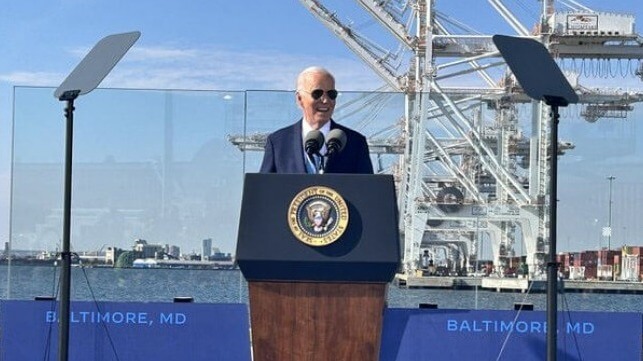President Biden Unveils EPA’s $3 Billion Investment in Clean Ports

President Joe Biden traveled to the Port of Baltimore today, October 29, to announce that the EPA has selected 55 applications from across 27 states and territories for an investment of nearly $3 billion under the Clean Ports Program. The program which is part of the administration’s broader infrastructure investments will support a wide range of projects for infrastructure, climate and air quality planning at U.S. ports that will include deploying zero-emission equipment and a conversion to shore power.
“Our nation’s ports are critical to creating opportunity here in America, offering good-paying jobs, moving goods, and powering our economy,” said EPA Administrator Michael S. Regan releasing the details of the awards. “Today’s historic $3 billion investment builds on President Biden’s vision of growing our economy while ensuring America leads in globally competitive solutions of the future.”
The EPA highlights that port and freight equipment responsible for moving goods including trucks, locomotives, marine vessels, and cargo-handling equipment contribute to significant levels of diesel air pollution at and near port facilities. Regan said the funds announced today will improve air quality at ports across the country by installing clean, zero-emission freight and ferry technologies along with associated infrastructure, eliminating more than 3 million metric tons of carbon pollution, equivalent to 391,220 homes' energy use for one year.
Among the ports that are designated to receive significant financial support is the Port Authority of New York and New Jersey ($344 million), Port of Oakland, California ($322 million), Maryland Port Administration ($147 million), Georgia Ports Authority ($49 million), Philadelphia Regional Port Authority ($77.7 million), Northwest Seaport Alliance in Washington State ($3 million), Puerto Rico Ports Authority ($1.8 million) and Port of Houston Authority ($3 million). The program also includes inland ports with the Port of Detroit, Michigan ($21.9 million).
In February 2024, EPA announced two separate funding opportunities for U.S. ports – a Zero-Emission Technology Deployment Competition to directly fund zero-emission equipment and infrastructure to reduce mobile source emissions and a Climate and Air Quality Planning Competition to fund climate and air quality planning activities. The competitions closed in May 2024 with over $8 billion in requests from applicants across the country seeking to advance next-generation, clean technologies at U.S. ports.
After a thorough and rigorous grant application review process, EPA reports it selected 55 applications to receive these investments. The projects focus on a wide range of equipment at and around ports, with funds supporting the purchase of zero-emission equipment, including over 1,500 units of cargo handling equipment, 1,000 drayage trucks, 10 locomotives, and 20 vessels, as well as shore power systems, battery-electric and hydrogen vehicle charging and fueling infrastructure, and solar power generation.
Among the specific projects, New York and New Jersey will deploy electric cargo handling equipment and drayage trucks with supporting infrastructure, PANYNJ plans to scrap a port of its existing fleet of equipment and will use a portion of the funding for the installation of shore power. Georgia will upgrade the ports of Savannah and Brunswick with shore power systems while Philadelphia will focus on deploying zero-emission port equipment. Oakland plans to deploy electric and hydrogen cargo handling equipment, drayage trucks, charging infrastructure, and a battery energy system.
Funding for these projects is included in the Inflation Reduction Act passed by Congress in 2022. A full list and details of the programs receiving the grants were posted online by the EPA.
No comments:
Post a Comment